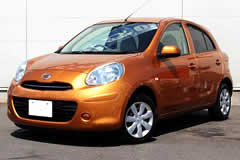How the Nissan March Has Changed Over 4 Generations - Vol.299
The Nissan March is without a great small car that has been around for more than 30 years. Here we'll take a look how the car has changed over the course of 4 generations.

1st Generation (1982 - 1992)
The March was Nissan's first 1 liter sized engine car, designed to be an economical introductory car for young families and new drivers. The aesthetic had European influences and the body size was categorized as relatively small and lightweight within the compact class of vehicles.
It was specified to fit 5 people yet initially was only available in a 3 door model. The 5 door would not be offered until a year after launch. At its peak its engine would typically produce 52 horsepower, and 3 gearbox's were on offer at launch, 5 gear manual, and two versions of automatic, one with 3 speeds and the other with 4.
3 years after launch a model was introduced with a Turbocharged engine fitted. This block produced around 80+ horsepower and became commonly known as the Turbo edition of the model.
Shorty after 1988 Nissan released a supercharged model of the March in sync with their aims to enter motor sport. This engine could produce around 110 horsepower. Along with the increase in power late 80's and early 90's models were fitted with improved interiors and standardized racing bodywork.
The March became quickly recognized as the little sports car anyone could own, as many considered it one of the most affordable compact cars with a decent power output in the market.
2nd Generation (1992 - 2002)
In 1992 Nissan brought to the market a completely reworked model of the March, which meant its entry into a second generation of the design. Following the trend of rounder lines in automobile aesthetic fashion at the time, the second gen March replaced its 1st generation hard straight lines with a more curvy and softer look.
The car was made a little shorter while increasing its capacity for passenger and luggage space. One of the most notable improvements was the feature of air conditioning and power steering fitted as standard.
Two engines were made available, one that produced up to 58 horsepower, and a more powerful 75+ horsepower unit. In 1994, Nissan started releasing only models that included SRS approved airbags in the dashboard.
In late 1999, a 4 wheel drive model was released that could produce 85 horsepower, which was the most balanced and sporty version of the design to this point.
3rd Generation (2002 - 2010)
Early in the new millennium the March was given a makeover, with most changes being applied to the model's exterior body work. Ultra subtle curved surfaces were emphasized and the headlights were raised higher than previous versions to give the car a more authoritative character. This became one the of the models most defining features throughout this generation's versions.
The roof was raised and overall height increased to provide passengers greater head clearance, as well as side airbags for all passengers to keep up with developing road safety standards. Improvements were installed to the rigidity of the body and side door beams were fitted all in effort to improve the car's collision absorption ability.
Following versions within this generation brought minor increases in engine horsepower, drive stability and traction capability.
4th Generation (2010 onwards)
In 2010 Nissan launched the latest version of the March centering on a circle motif concept. The car has kept its curvy exterior, but innovative design elements have been introduced to the interior features and instruments to provide consumers a more fashionable dynamic environment.
The engine is still a high 70 horsepower unit, which combined with a its new generation fuel consumption systems manages a consumption of as low as 26 km/L, which earnt the 2010 March a Fuel Consumption Standard +25% Certification.
The latest models feature a more ornate looking front grill in the shape of a V, which has become one of the cars most defining aesthetic characteristics.